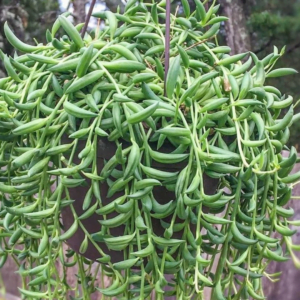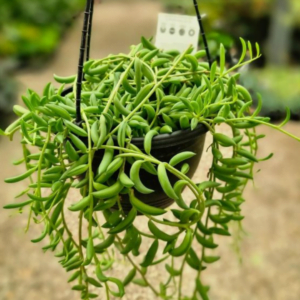Introduction
Indoor plants have long been admired for their ability to bring life, color, and vitality to any space. One particular variety, the String of Bananas (Senecio radicans), has gained traction among houseplant enthusiasts for its unique appearance and relatively easy care regimen. This trailing succulent, with its elongated banana-shaped leaves, serves as an ideal decorative piece for hanging baskets or shelves. This review provides an exhaustive guide to care for this delightful plant, ensuring its thriving condition and robust growth.
String of Bananas (Senecio radicans) Indoor Plant Details
| Key Specification | Details |
|---|---|
| Common Names | String of Bananas, Necklace Plant, Banana Vine |
| Botanical Name | Senecio radicans |
| Family | Asteraceae |
| Plant Type | Succulent, trailing |
| Mature Size | Up to 2-3 feet in length when kept indoors |
| Sun Exposure | Bright, indirect light. A few hours of direct morning or late afternoon sun is beneficial but avoid harsh midday sunlight. |
| Soil Type | Well-draining soil. A cactus or succulent mix is ideal, which can be amended with sand or perlite for added drainage. |
| Soil pH | Slightly acidic to neutral, typically between 6.0 to 7.5 |
| Bloom Time | Fall, although blooming is rare when grown indoors. |
| Flower Color | Small, white flowers with a light cinnamon-vanilla scent. |
| Hardiness Zones | 9b to 11b. Best suited for indoors in most regions unless you reside in a frost-free climate. |
| Native Area | South Africa, where it thrives in arid and semi-arid conditions |
The String of Bananas, with its unique banana-shaped trailing leaves, makes for an eye-catching indoor plant. Its ease of care, combined with its whimsical appearance, ensures its popularity among plant enthusiasts. Whether displayed in hanging baskets or cascading from a high shelf, this plant offers an unmatched aesthetic appeal. Proper care, as detailed in the specifications above, guarantees a healthy, thriving plant that serves as a conversation starter in any setting.
Plant Care
Caring for the String of Bananas, like any other indoor plant, requires understanding its native habitat. Originating from South Africa, this succulent is accustomed to periodic rainfall and long durations of sunlight. This knowledge will play a pivotal role as we delve deeper into its care requirements.
Light
Sunlight plays an integral role in the health of the String of Bananas. The plant thrives best in bright, indirect light. A southern or western-facing window would be ideal, though it’s essential to shield the plant from any direct sunlight that can scorch its delicate leaves. If you’re relying on artificial light, ensure the plant receives at least 12 hours of light for optimum growth.
Soil
The right soil mix is crucial. Since this is a succulent, a well-draining soil mixture will work best. You can opt for a cactus or succulent mix available at most nurseries. To further enhance drainage, consider adding some perlite or coarse sand to the mix. A properly aerated soil ensures the roots remain healthy and free from rot.
Water
One of the most common mistakes with succulents is overwatering. String of Bananas prefers to dry out between waterings. A good rule of thumb is to water deeply but infrequently. Check the top inch of the soil, and if it’s dry, it’s time to water. Ensure that the pot has sufficient drainage holes to prevent waterlogging.
Temperature and Humidity
Being a native of South Africa, this plant enjoys warmer temperatures. Ideal temperatures range from 70 to 80°F during the day and no less than 50°F at night. Although it can handle a bit of humidity, it’s essential to ensure good air circulation to prevent mold or fungal issues.
Fertilizer
Though not a heavy feeder, providing the String of Bananas with a diluted succulent fertilizer every 4-6 weeks during its growing season (spring and summer) can support its growth. In fall and winter, it’s best to cut back on feeding as the plant goes into dormancy.
Pruning
Pruning is not just about maintaining the plant’s aesthetics. By removing dead or overgrown strands, you are promoting a healthier growth pattern. Periodic trimming can also stimulate bushier growth, making the plant look even more vibrant.
Overwintering
Come winter, the plant’s growth slows down. During this period, it’s crucial to reduce watering and ensure the plant is kept in a location free from drafts or sudden temperature fluctuations. If you live in an area with cold winters, consider moving the plant to a warmer spot indoors.
Propagating Plant
Propagating the String of Bananas is a straightforward affair. By taking a cutting with a few banana-shaped leaves and letting it root in water or soil, you can produce a new plant. This method allows enthusiasts to share this delightful plant with friends or expand their collection.
Quickly Declining
Despite the ease of care, sometimes plants may show signs of decline. Yellowing leaves, shriveling stems, or root rot can be indicators of problems. More often than not, overwatering or inadequate light might be the culprits. Regularly monitoring and adjusting care routines can help address these issues.
Types of Plant
The String of Bananas belongs to the Senecio genus, which consists of a diverse range of plants. While the String of Bananas (Senecio radicans) is our focal plant, it’s worth noting that there are other similar trailing succulents like the String of Pearls (Senecio rowleyanus) and String of Beads. Each variety has its unique charm and slightly varying care requirements. Knowing the specific type of plant you own can help tailor your care regimen.
Common Pests & Plant Diseases with Solutions
Pests:
a. Mealybugs: Small, white, cotton-like pests that suck sap from the plant.
Solution: Wipe them off with a soft cloth dipped in rubbing alcohol. Neem oil can also act as an effective deterrent.
b. Spider mites: Tiny mites, often resulting in web-like structures on the plant.
Solution: Keep humidity levels high, and occasionally showering the plant can deter them. For severe infestations, insecticidal soap or neem oil may be used.
Diseases:
a. Root Rot: Caused by overwatering, leading to a fungal infection in the roots.
Solution: Repot the plant in fresh, dry soil, trimming away any affected roots. Ensure proper drainage in the future.
b. Powdery Mildew: A white, powdery substance on the leaves.
Solution: Reduce humidity, increase air circulation, and consider a fungicidal treatment if the problem persists.
How to Get the String of Bananas to Bloom
Achieving blooms in the String of Bananas can be a delightful surprise for plant owners. While the blooms might not be as flashy as other plants, their subtle beauty and fragrance make them special. To encourage blooming:
- Light Exposure: Ensure the plant receives adequate light, as mentioned earlier.
- Proper Watering: Maintaining a proper watering routine, allowing the plant to dry out between waterings, can stimulate blooming.
- Temperature Stress: Slightly cooler night temperatures in the fall can trigger the blooming phase.
- Fertilizer: Providing the right nutrients during the growing season can support overall plant health, increasing the chances of flowering.
Common Problems With Plant
a. Leggy Growth: Often due to insufficient light, making the plant reach out for more. Solution: Move the plant to a brighter location.
b. Brown Tips on Leaves: Can result from low humidity, over-fertilization, or tap water filled with chemicals. Solution: Mist the plant occasionally, use filtered water, and ensure you’re not over-fertilizing.
c. Dropping Leaves: Usually a sign of overwatering. Solution: Let the soil dry out completely before watering again.
d. No Growth: If the plant seems stagnant, it might be root-bound or lacking nutrients. Solution: Repot in a slightly bigger container and ensure regular fertilization during the growing season.
Plant Care Reflections
Having a String of Bananas plant in one’s collection is truly a joy. Their quirky appearance and flowing nature make them a centerpiece of any plant collection. With the right care and attention, they not only thrive but also become a testament to the wonders of nature.
Plant Care Reflections
Nurturing a String of Bananas requires an understanding of its inherent nature and a touch of love. Like all plants, it’s not just about providing the essentials but also tuning into its subtle cues. A flourishing String of Bananas plant can be a testament to the joy and beauty it brings into any living space.
Frequently Asked Questions
Decode the magic of gardens with our guide to Landscaping Styles Frequently Asked Questions.
- It’s best to repot when the plant becomes root-bound or outgrows its container, typically every 2-3 years.
- Yes, they can be toxic to pets if ingested. It’s advisable to keep them out of reach of cats and dogs
- Shrivel can be a sign of underwatering. Check the soil moisture and adjust your watering routine.
- In warmer climates or during summer months, it can be placed outdoors in a shaded area. However, it’s essential to protect the plant from direct sunlight and bring it indoors during colder months.
Recent Posts
- Modern Mural Ideas Transforming Walls into Artworks
- Thematic Table Decor Dressing Your Table for Special Occasions
- Festive Lighting Ideas Brightening Your Home for the Holidays
- Biodegradable Decor Materials Choosing Earth-Friendly Options
- Personalized Space Decor Making Your Home Uniquely Yours
- New Year’s Eve Decor Ringing in the New Year in Style
- Transforming Junk into Decor Upcycling at Its Best
- Second-Life Decor Objects Giving Old Items New Purpose
- Unique Decoration Crafting Standout Ideas for Your Home
- Environmentally Friendly Styling Decor with a Conscience











